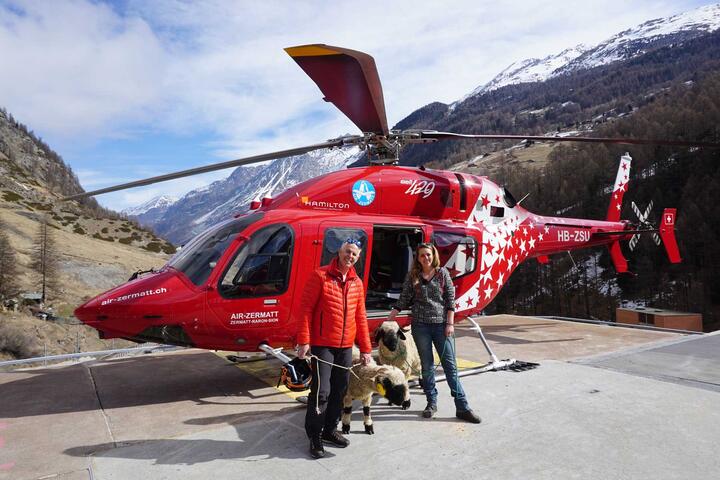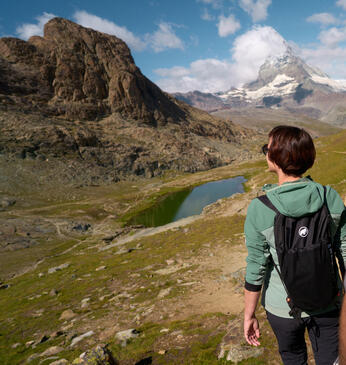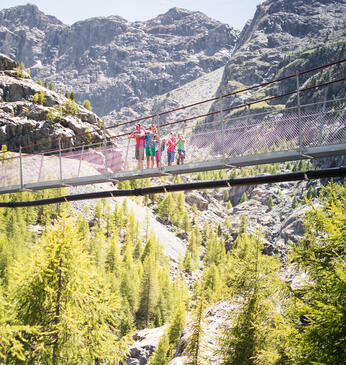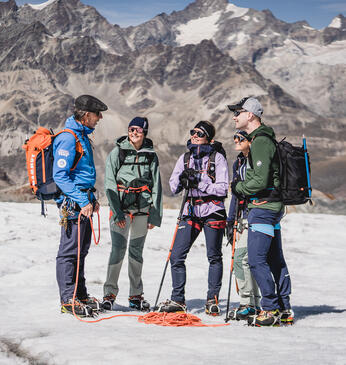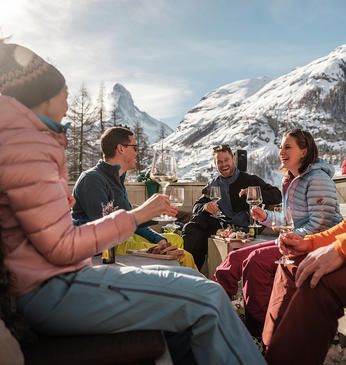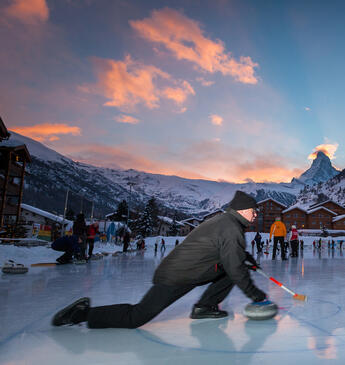“The sheep can also look for their mountain herbs and enjoy their quiet herd presence this summer,” said the 30-year old sheep breeder Rebecca Julen. Her black-nose sheep are the most important part of her life. Therefore, she would never allow her sheep to be subjected to the stress of a training programme or be exposed to the noise of a helicopter time and again. “Appropriate animal welfare means allowing the animals to be who they are,” she continues and scratches one of her black-nose sheep on its black nose. This means, that the nearly 300 sheep of the Julen sheep breeding family are let out of their winter quarters in May each year. They then move onward and upward in stages and on their own as they themselves seek their meadows for grazing. “Black-nose sheep have a strong personality but they are also very loyal herd animals,” says Rebecca Julen. The older sheep know the best spots for great herbs and also can find where there are cool rock outcrops to cool off their heads heated in the high-altitude sun and where they can peacefully ruminate. However, one statement in yesterday’s press release is true: “Black-nose sheep really are especially familiar with their local terrain and know how to move about safely in the steep landscape,” says Julen.
Gerold Biner, CEO of Air Zermatt and a helicopter rescue pioneer is also happy that the sheep have not been retrained as rescue sheep: “Dog handlers and their dogs are very welcome when there is an on-going search for missing persons. But I would have to think twice about sheep,” he says.
The helicopter pilots at Air Zermatt along with the rescue station mountain guides are among the world’s leading pioneers of mountain rescue. Quickly finding and rescuing the injured has been one of their core skillsets for years. They have little time and no desire to take part in risky experiments.
The Characterful Black-Nose Sheep
The black-nose sheep have been at home in Upper Valais for years. Different breeding associations and clubs have taken on the task of raising this special breed. Their features include: black face and ears, the females may also have a black spot on their backside. The black-nose sheep have a special, well-insulated wool coat, which stands up well against hot and cold mountain air. Their bodies are very robust and their legs are powerful. Their deportment is adapted to the conditions in the mountains: “We constantly watch our animals. While doing so, we can observe how the older sheep teach the younger sheep about what they need to know to survive,” explains Rebecca Julen. This means that they know about the dangerous slopes and what to do in storms and summer snowstorms.
Visit the Sheep
The black-nose sheep of the Julen family can be visited on their meadow during the summer with a guided tour by a sheep breeding family member, such as Paul or Rebecca Julen. This is a wonderful experience for everyone and especially for families with children.
---
Pioneer work in Zermatt: This summer a pilot attempt will be made with the integration of sheep into the Alpine rescue effort. A few sheep have already been trained to look for and find injured hikers on their own in the Alpine area so that they can then be rescued in the shortest time possible.
"We are taking a major step forwards in mountain rescue beginning this summer," says the helicopter pilot and CEO of Air Zermatt, Gerold Biner. In collaboration with the 30-year old Zermatt sheep breeder, Rebecca Julen, a programme was developed for training the sheep as rescue sheep. "The latest studies show that sheep have qualities, which were not known by scientists until now. However, we sheep breeders have known for some time that black-nose sheep are amazingly good at orienting themselves in the mountains," said Rebecca Julen. In addition, their sure-footedness, no fear of heights, terrain intelligence and weather resistance are better developed than in the search dogs. "Our sheep know precisely how to get from A to B as quickly as possible in the mountains. Therefore, they are predestined to provide assistance in an Alpine setting," emphasises Rebecca Julen. This summer, the "rescue sheep" project will be launched.
Alpine rescue was developed in Zermatt in the 1960s – with helicopters, rescue columns of mountain guides, and including rescue dogs. Therefore, it is obvious that the local experts assume a pioneering role to take this unconventional step: "The first sheep have already completed various training units," says Gerold Biner, CEO of Air Zermatt.
Preliminary work ran continuously all winter long. A training camp suitable for the animals was set up in a stall for a team of selected sheep. And this is how the "rescue sheep" project works: The trained sheep move together with their herds over the open Alpine meadows throughout the summer. As soon as the trained black-nose sheep sense, hear or smell that a hiker is in trouble or even has collapsed in the meadow, they immediately set off for the injured person. Since they wear an SOS set on their bodies, the injured person can call for help. The set has a clearly visible emergency button, which the victim can press, and this sets off the Sheep Alarm at the Air Zermatt helicopter base. The pilot flies towards the GPS location transmitted by the SOS set. The set also has First Aid medication and material, which the missing person can use until the helicopter arrives. This is similar to the St. Bernard dogs with their schnapps barrels, which were the legendary rescuers back then. "With modern technology and well oriented sheep, we are working on taking a new approach to the rescue process," says the helicopter rescue specialist Gerold Biner.






